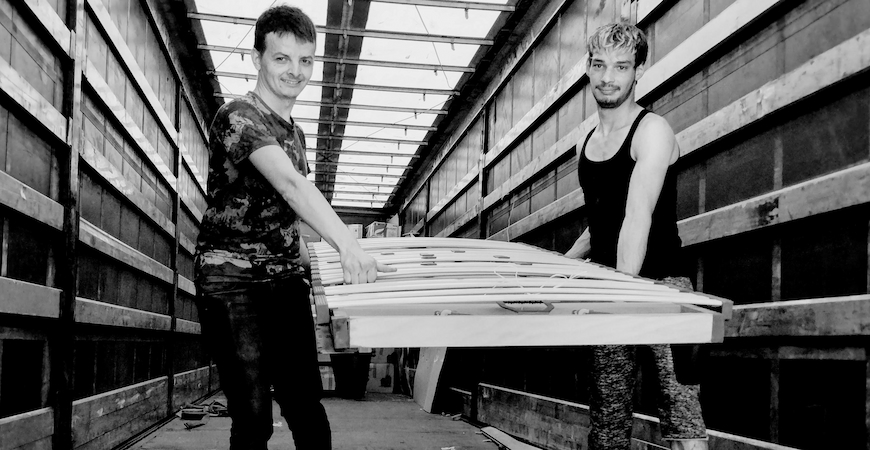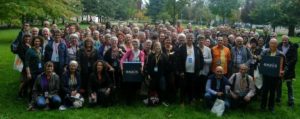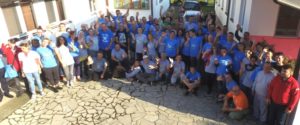Container loads – solidarity that goes beyond donated goods
Meeting with Jean-Philippe, the leader of Emmaus Satu Mare, Romania. He tells us about how container loads are arranged, but above all, reveals what underpins these initiatives to share donations between the Emmaus groups who receive a lot of donated goods, and those who receive less.
Can you give us a quick overview of Emmaus Satu Mare?
Our community is home to 25 young people aged 18-30. They are care system leavers. They are particularly vulnerable, and most of them have experienced trauma during their childhood and teenage years. They come to us with major interpersonal, educational, inclusion and other issues.
We are therefore at a crossroads between a community and a social enterprise. On the one hand, the community: the companions learn to live independently, take care of themselves, etc. All of this is linked to in-depth educational work: getting back into education, individual discussions and support groups on certain topics (managing emotions, relationships, etc).
And on the other, the social enterprise: two furniture shops, bric-a-brac…which give the young people work experience, and enable Emmaus Satu Mare to cover its costs.
Where does the stock for the two shops come from?
Just like most Emmaus groups, we collect locally, but this is inevitably limited: there is no culture of giving in Romania, and we receive poor-quality donations, and even waste… There is a real risk of waste being sent to landfill when it is dumped in wheelie bins, as recycling facilities have not been developed here.
Most of our stock is therefore supplied by solidarity container loads, sent by Emmaus partner groups with whom we have forged strong links.
What underpins this type of partnership and connection between Emmaus groups?
While the financial support provided by the solidarity container loads is vital, these partnerships are also the chance to forge real relationships with the other groups in Europe via companion exchanges, group visits, etc.
Many of our young people undertake internships in our partner groups. They spend several days or weeks there, preparing the next load, and also learn a lot about life outside their community. They “fly the nest” as it were, and find themselves in a new yet protective setting, which turns upside down their habits (new language, rubbing shoulders with older people, etc.). Most of the young people come back more mature, with increased self-confidence. These exchanges are truly beneficial. They have been referred to as a “companion Erasmus scheme”, and that definitely rings true!
And when difficulties arise during their time at a partner community, it constitutes an opportunity for them to learn about their limits, and gives us ideas on how better to support them. We are lucky enough to have trusted partners, who are willing to “give it a go” alongside us.
From a logistics perspective, what does “sending a container” actually involve?
First things first: it isn’t difficult to send a container! There is a little bit of admin, which is relatively easy to complete. We find a haulier at our end.
The challenging part is the “content” of the container: the quality and quantity of donations. A truck that is only 70% full will have an impact on the profit generated, and on our economic model. Likewise, a load of poor quality goods is very likely to end up in the bin, with the risk of being sent to landfill. In both scenarios, the environmental impact will also go against the values that we champion at Emmaus.
The new issue is the rising cost of fuel, and Romania has not been spared. Currently, a container load generates turnover of €7-9,000 for Satu Mare, while transport costs amount to roughly €3,000 (as opposed to €2,200 last year). The quality and quantity of donations are therefore crucial to making a profit from the load and in order to be in keeping with our principles.
What is an ideal load then?
One that combines interaction, quality and quantity! One option is for the young people to travel to the sending group to select the contents of the container, help with loading, and motivate everyone to load the container as well as possible. Although this costs money, it is really important for forging long-term relationships, and as stated above, it is a great experience.
Another good practice (for the sending group) is to carefully study the receiving group’s needs. The idea is for the goods to be what our local customers actually want to buy. Last year, we met two groups, and together we drew up a detailed list of our needs: furniture style, knick-knacks, type of crockery, without even taking into account how items are packaged, “knocked about” during loading, shipping, and unloading. All of these issues are important!
We have longstanding links with other groups who are up to speed with our needs, and we feel “at home” when we take part in loading a container.
What would you like to say to a group that wants to get more involved in international solidarity and in container loads in particular?
Container loads are a very “Emmaus” way of undertaking and receiving solidarity. They are tangible, as they involve the companions, employees and volunteers in the sending group; this generates a real and palpable benefit for the receiving group’s companions. Container loads are not just another activity; instead they are part of Emmaus’ DNA: donations to Emmaus are shared, providing work for an entire community, and bringing it alive. And it’s a wonderful adventure!
Is there anything that I haven’t asked that you would like to add?
There is always more to say! We are very grateful to the Emmaus groups who have been supporting us for a long time. And we recommend that those who are still unsure do embark on the adventure, with us or with other European groups who also need donations, in Romania, as well as in Poland, Bosnia-Herzegovina, and in the Baltic nations!

Two young people from Emmaus Satu Mare unloading a container from Emmaus Chaux de Fonds, Switzerland, May 2022, Romania - © Emmaus Satu Mare



